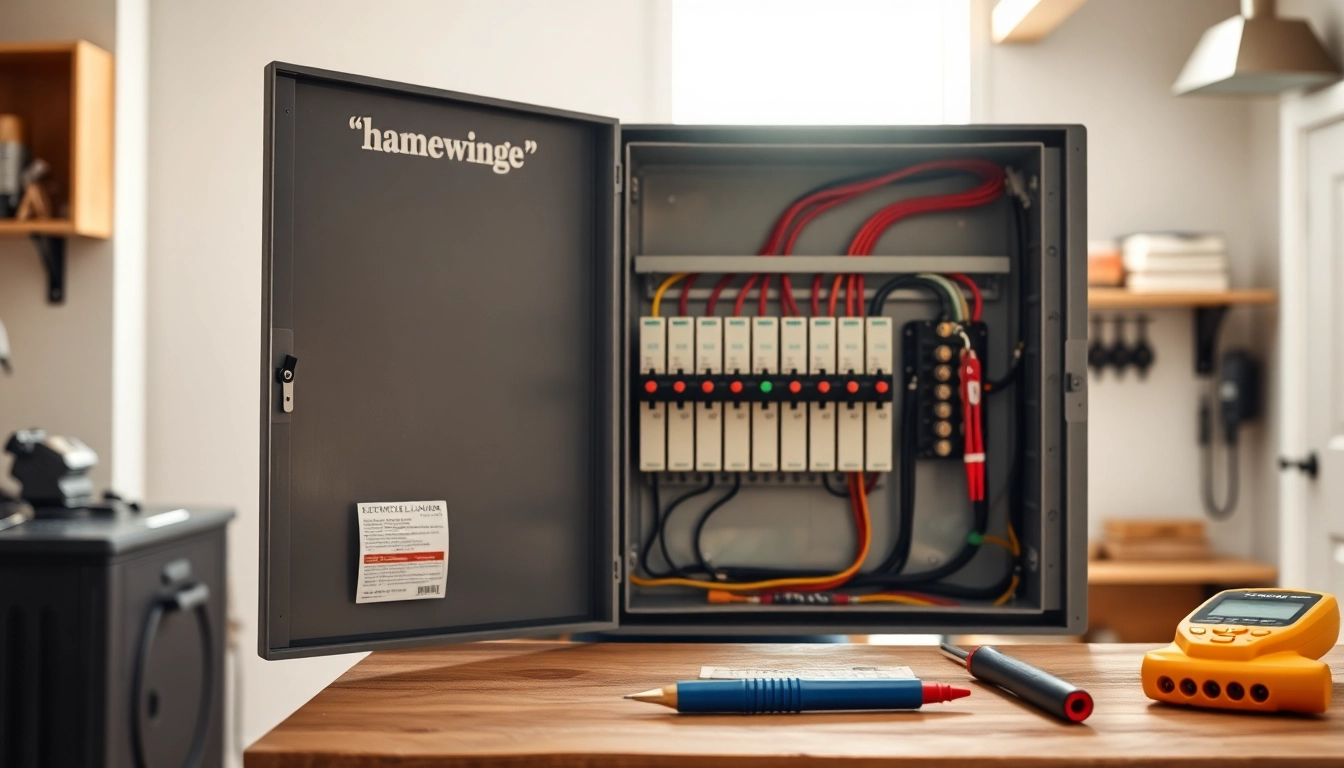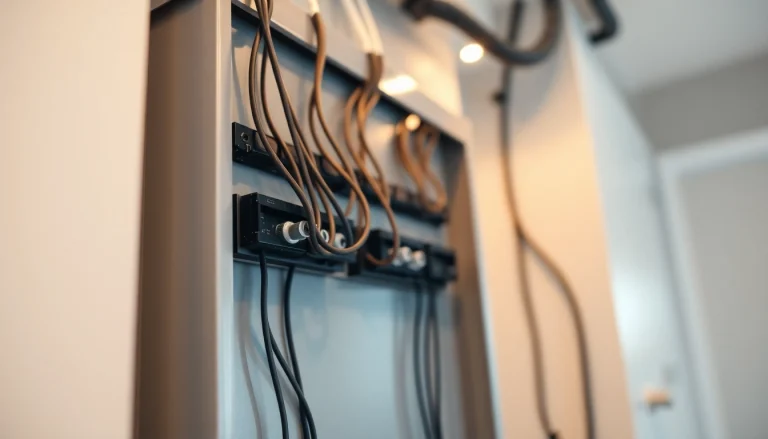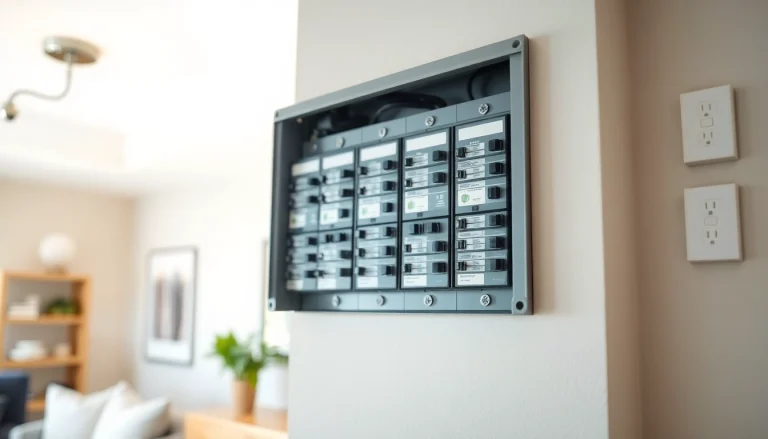Understanding the Electrical Panel: Basics and Functions
What is an Electrical Panel?
An Electrical Panel, often referred to as a breaker box, serves as the central hub for the electrical system in a home or a building. It is designed to either distribute electricity through various circuits or to protect these circuits from overloads and short circuits. Primarily, it converts high-voltage electricity from the utility into usable low-voltage power for household appliances and fixtures. Essentially, the electrical panel lays the groundwork for safe and reliable electricity use throughout your residential space.
How Electrical Panels Work
The functionality of an electrical panel can be broken down into several key aspects. It takes in electricity from the electrical utility, typically at a level of 120/240 volts, and directs it to the appropriate circuits within your home. This is achieved through a series of circuit breakers or fuses that act as safety devices. When the demand for electricity is too high, these devices will “trip,” cutting off the electrical supply to prevent potential hazards such as fires or equipment damage.
Additionally, electrical panels are outfitted with a main switch that allows the homeowner to cut off all electrical supply. This is especially useful during maintenance or in case of severe electrical faults. Understanding how these components interact is crucial for homeowners in order to effectively manage and maintain their electrical systems.
Common Components of an Electrical Panel
Electrical panels contain multiple essential components, including:
- Main Breaker: The primary switch that controls power to the entire panel.
- Bus Bars: Conductors that distribute electricity to various circuit breakers.
- Circuit Breakers: Switches that protect individual circuits from overloading or short circuits.
- Neutral and Ground Bars: These serve as connection points for neutral wires and grounding wires, respectively.
- Access Door: A protective cover that allows safe access to the internal components.
Understanding these components can aid homeowners in recognizing the overall function and important maintenance practices for their electrical panels.
Signs You Need to Upgrade Your Electrical Panel
Increasing Electrical Demand
As household appliances become more energy-intensive, the demand for electrical load increases. Modern homes often utilize an array of devices like air conditioning units, smart home systems, and advanced kitchen appliances. If you constantly find yourself tripping circuit breakers or repeatedly using power strips to accommodate your devices, it might be time to consider upgrading your electrical panel to meet the increased demand.
Old or Outdated Systems
Older electrical panels, particularly those installed before the 1990s, are often incapable of handling the electrical load of today’s homes. These outdated systems can also significantly increase the risk of electrical fires and other hazards. If your panel is several decades old, an upgrade not only enhances safety but also ensures compliance with current electrical codes.
Safety Concerns and Standard Compliance
When safety concerns arise, it is crucial to act promptly. Signs such as scorch marks around the panel, rust, or frequent tripping breakers indicate that the panel is failing. Additionally, there are updated electrical codes established to protect homeowners. If your electrical panel does not meet these codes, upgrading is necessary to comply with local regulations and protect your home.
Choosing the Right Electrical Panel for Your Home
Types of Electrical Panels
When it comes to choosing an electrical panel, it is essential to understand the various types available on the market:
- Main Breaker Panel: The most common type, featuring a single main breaker that controls all the circuits.
- Subpanels: These panels are used as an extension for larger homes or buildings, allowing for additional circuits without overcrowding the main panel.
- Transfer Switches: Essential for homes utilizing a generator, these switches allow for a seamless transition between utility power and generator power.
Assessing the layout of your home, the total amperage required, and your specific electrical needs will guide you toward the optimal choice for your Electrical Panel.
Factors to Consider When Upgrading
Several factors should be taken into account when considering an upgrade:
- Amperage Rating: Most homes utilize electrical panels rated between 100 to 200 amps. It is crucial to analyze your household’s total energy needs to find the right amperage.
- Number of Circuits: Depending on the number of devices and appliances you plan to connect, ensure the panel has ample circuits available.
- Brand and Quality: Choose panels from reputable manufacturers that offer solid warranties and customer support.
Electrical Panel Ratings: What You Should Know
Electrical panel ratings are determined by their amperage, voltage, and the type of circuits supported. The most common ratings are:
- 100 Amps: Generally suitable for smaller homes with limited electrical needs.
- 150 Amps: Often serves the needs of medium-sized homes with more appliances and devices.
- 200 Amps: Recommended for larger homes or those that require higher electricity demands due to modern appliances.
Assessing your household energy consumption will help in selecting the appropriate rating for your panel.
Best Practices for Maintaining Your Electrical Panel
Regular Inspections and Maintenance
Conducting regular inspections of your electrical panel can prevent complications and dangerous situations. At minimum, a yearly inspection is advisable. Homeowners should check for signs of wear and tear, moisture, and rust, and ensure that all circuit breakers are functioning correctly. It’s also prudent to keep the panel clean and free from debris or obstructions.
Signs of Wear and Tear
A few indicators suggest your electrical panel requires immediate attention:
- Burn Marks: These are often the result of poor connections and indicate potential fire risks.
- Buzzing Sounds: If your panel emits noise, it may signify loose components or overloaded circuits.
- Flickering Lights: This could indicate insufficient power delivery from the panel.
Recognizing these signs early can save homeowners from more extensive and expensive repairs.
How to Safely Reset Circuit Breakers
Resetting a tripped circuit breaker is a straightforward process, but it must be done with caution:
- Locate the breaker switch that has been tripped. It will often be in a position opposite to the others.
- Turn the switch to the OFF position before turning it back to the ON position.
- Ensure the cause of the trip has been resolved to prevent further issues.
Understanding this process is integral to maintaining a safe electrical environment within your home.
Cost Considerations for Upgrading an Electrical Panel
Factors Influencing Upgrade Costs
The cost of upgrading an electrical panel can vary widely depending on several factors, including:
- Labor Costs: The fees charged by electricians vary based on their experience and region.
- Panel Cost: The price of the panel itself will vary with brand preferences, size, and features.
- Location: Geographic location plays a crucial role in determining overall installation costs.
Budgeting for Installation and Components
On average, homeowners should budget between $1,500 to $3,000 for a complete panel upgrade. This estimate may include the cost of the panel, labor, and any necessary upgrades to the wiring. Always request multiple quotes to ensure accurate pricing.
Comparing DIY vs. Professional Installation Costs
While some homeowners may consider DIY panel upgrades, it is recommended to hire a licensed electrician due to the complexity and risks involved. Incorrect installation can lead to unsafe conditions, regulatory violations, and void insurance coverage. The costs saved from a DIY project rarely outweigh the potential for safety hazards and subsequent repair bills, making professional installation the safest choice.








